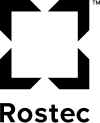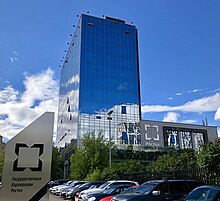Loading AI tools
Russian state-owned defense conglomerate From Wikipedia, the free encyclopedia
Rostec (Russian: Ростех, romanized: Rostekh), formally trading as State Corporation "Rostec" (Russian: Государственная корпорация «Ростех»), fully the State Corporation for the Promotion of the Development, Manufacture, and Export of High Tech Products "Rostec" (Russian: Государственная корпорация по содействию разработке, производству и экспорту высокотехнологичной промышленной продукции «Ростех») and formerly Rostekhnologii (Russian: Ростехнологии, lit. 'Rustechnology'), is a Russian state-owned defense conglomerate headquartered in Moscow.[5]
 | |
 | |
| Rostec (Ростех) | |
Native name | Государственная корпорация «Ростех» |
Romanized name | Gosudarstvennaya Korporatsiya "Rostekh" |
| Formerly | Rostekhnologii |
| Company type | State corporation |
| Industry | Conglomerate (ISIC: 6420) |
| Founded | 23 November 2007 |
| Founder | Vladimir Putin by signed law[1] |
| Headquarters | , |
Area served | Worldwide |
Key people | Denis Manturov (Chairman) Sergey Chemezov (CEO) |
| Revenue | |
| Owner | Federal Agency for State Property Management |
Number of employees | 453,000[4] (2016) |
| Divisions | Aircraft, Electronics, Armament |
| Subsidiaries | See § Organization |
| Website | www |
Established in 2007, the organization comprises about 800 enterprises, which together form 15 holding companies:[6] eleven in the defense-industry complex and three in civil sectors. Rostec's organizations are located in 60 constituents of the Russian Federation and supply goods to over 70 countries worldwide.[7][8]
The organization is headed by Sergey Chemezov, appointed to the position by Russian President Vladimir Putin.[9][10] The 2014 EU sanctions listing for Chemezov describes how Rostec subsidiaries supported Russia's annexation of Crimea.[9][11]

On 23 November 2007, Russian President Vladimir Putin signed federal law No. 270 to establish a state corporation named Rostekhnologii, which was previously passed by the State Duma on 9 November and passed by the Federation Council on 16 November.[1][12][13][14][15]
On 10 July 2008, newly elected Russian President Dmitry Medvedev signed a decree that transferred 443 struggling enterprises to ownership by Rostekhnologii. Of these enterprises, 30% were in pre-crisis and crisis condition, 28 were in bankruptcy proceedings, 17 had no business operations, and 27 had lost part of their assets or faced a material risk of such loss, and in total they faced a debt of RUB630 billion. In addition, these enterprises had worn out fixed assets, dilapidated production chains, and poor management.[13][16][17]
After the acquisition, structural reforms were made, helping the enterprises emerge from their financial struggles with a 20–30% increase in production growth, five times the national average. Most of the profits were acquired by Rostekhnologii, which 80% of it was from 20% of Rostekhnologii's assets. The 20% included AvtoVAZ, KamAZ, the titanium monopoly VSMPO-AVISMA, and helicopter manufacturers Mil and Kamov. This in turn brought executives of some companies into conflict with each other, such as the case with Mil and Kamov, in which they refused to communicate with each other. As a result, Rostekhnologii had to work with the two companies so they can cooperate with each other.[17]
On 21 December 2012, Rostekhnologii rebranded itself as Rostec to make the corporation more open to the world. Rostec also featured a new logo, an open square symbolizing a window to the world and a focus frame, as well a new slogan "Partner in development" and implemented changes in its corporate governance structure.[13][18][19][20] The corporation spent $1.5 million for rebranding.[19] The corporate brand, which was launched in late 2012, is currently one of Russia's 15 most valuable brands and has a value similar to that of major companies such as Rosneft and Rostelecom.[21]
On 16 July 2014, as a result of Russian intervention in Ukraine and Russian annexation of Crimea, Rostec was one of the companies that was sanctioned by the Obama administration. Sergey Chemezov, current CEO of Rostec, was one of the individuals targeted by the United States (US) and the European Union (EU), whose visa was banned and assets frozen by the EU. Rostec's access to US debt markets was also limited. Rostec was forced to rethink its strategy for its holding companies.[22][23][24][25]
In December 2015, Rostec's supervisory board approved its development strategy through 2025. According to the strategy, Rostec intends to change the Russian economic model by putting less emphasis on weaponry, aviation components, and software and more emphasis on electronics, telecommunications, robotics, and other high-tech industries. This in turn would diversify the Russian economy, increasing the share of high-tech civilian products and non-primary exports.[13][26][27]
According to the current development strategy of the corporation, by 2025 the share of civilian products in its revenue should be 50%.[28][29]
It was reported in late 2022 that Rostec had greatly increased the production of armored vehicles and ammunition in response to the 2022 Russian invasion of Ukraine.[30][31][32]
Rostec announced on 5 January 2023 that it will commence mass manufacture of new C-UAS EW systems in two months.[33]
Chemezov stated in May 2023 that the company's revenue in 2022 was $27.2 billion and the share of civilian production had reached 45%.[34]
It was reported in August 2023 that Rostec's enterprises have increased the production of armored vehicles by 4 times and the production of ammunition for barrel artillery and MLRS by 20-30 times since February 2022.[35][36][37]
It was reported in September 2023 that Rostec's enterprises have increased the production of various types of weapons 2-to 10-fold.[38]
Sergey Chemezov claimed on 1 November 2023 that Rostec has increased over a year the production of tanks by 7 times, of other combat vehicles by 4.5 times, of artillery and MLRS by 2.5 times, and of ammunition by 60 times.[39]
Rostec reported in April 2024 that during the previous year it had increased the production of self-propelled artillery by 10 times, of towed artillery by 14 times, of mortars by 20 times, of MLRS by 2 times, of ammunition by 25 times (by 50 times for some types), of rounds for automatic and under-barrel grenade launchers by 5 times at comparison with the 2022. It also enhanced the production and repair of tank guns and artillery barrels twice, organized the production of munitions for drones and increased the production of guided artillery rounds and gliding bombs.[40]
Sergey Chemezov stated in May 2024 that the Corporation employed more than 660,000 people as of the end of 2023 and its revenue was 2.9 trillion rubles (31.6 bln US$).[41] A Rostec high-ranking official stated in August 2024 that Russia's total export orders for weapons first exceeded 60 bln US$.[42]

The supervisory board, the management board, and the General Director are all appointed by the President of Russia.[43]
The companies controlled by Rostec employ about 450,000 people.[46] A special focus of the corporation's responsibility on labor involves 21 dominant employers that are part of Rostec.[47] As an example of corporate activity aimed at stabilization of social environment in one-company towns, mass media covered Rostec's labor policy in relation to AvtoVAZ, a dominant employer in Togliatti during the 2008-2009 economic crisis. Despite large-scale layoffs, public unrest was prevented by a special employment program for dismissed workers.[48] The unemployment rate in the company town of Verkhnyaya Salda, Sverdlovsk Oblast, which is owned by VSMPO-AVISMA, is less than 1%.[49]
In order to implement its Health National Program, the corporation has set up nine centers for high medical technologies.[50] Five centers for cardiovascular surgery (Khabarovsk, Krasnoyarsk, Chelyabinsk, Perm and Kaliningrad), two centers for neurosurgery (Tyumen and Novosibirsk) and two centers for traumatic surgery, orthopedics and endoprosthesis replacement (Smolensk and Barnaul).[51]
Rostec is a participant in the Perinatal center development program along with Russia's Ministry of Health, the Federal Compulsory Medical Insurance Fund and federal member state authorities.[52][53]
As of March 2017, Rostec had built and equipped perinatal centers in 15 federal subjects of Russia:
Rostec cooperates with 312 leading higher educational institutions, including, among others, Bauman Moscow State Technical University, and the Plekhanov Russian University of Economics, through targeted training of specialists, development of cooperation in the framework of scientific and technological areas, joint research, design and technological work. There are 294 departments belonging to holding companies and enterprises under Rostec in these institutions.[55][56] In 2015, Rostec started 165 projects in collaboration with these institutions at a cost amounted to 2.8 billion rubles.[57]
On November 27, 2007, Rostec became general sponsor of FC Krylia Sovetov Samara; however, in 2011 the corporation decided to suspend its support of the team.[58] In 2010 and 2011, Rostec sponsored Vitaly Petrov, Formula One racing driver. In 2012, Russian Helicopters partnered with Caterham F1Team for which Petrov drives.[59] Improving professional training of the employees, Rostec cooperates with the WorldSkills movement.[60] In 2015 the Corporation and WorldSkills Russia concluded a cooperation agreement which is aimed mainly at the joint work on training specialists for high-tech industries. State Corporation Rostec is a general partner of WorldSkills Russia in accordance with a three-year agreement.[61]
As of late 2016, going by its development strategy, Rostec organizes its 700 enterprises into either directly controlled companies or clusters composed of holding companies.[62][63][64]
The preliminary financial performance for 2012 show that the overall revenue of Rostec exceeded RUR960 billion compared with RUR817 billion a year earlier.[65] Revenues from export to 70 countries globally exceeded RUR240 billion.[66]
Main financial indicators,[67] 2015 ($1 = 60,96 RUB):
The company's revenue in 2021 amounted to 2.06 trillion rubles (US$ 28 billion).[68]
Seamless Wikipedia browsing. On steroids.
Every time you click a link to Wikipedia, Wiktionary or Wikiquote in your browser's search results, it will show the modern Wikiwand interface.
Wikiwand extension is a five stars, simple, with minimum permission required to keep your browsing private, safe and transparent.